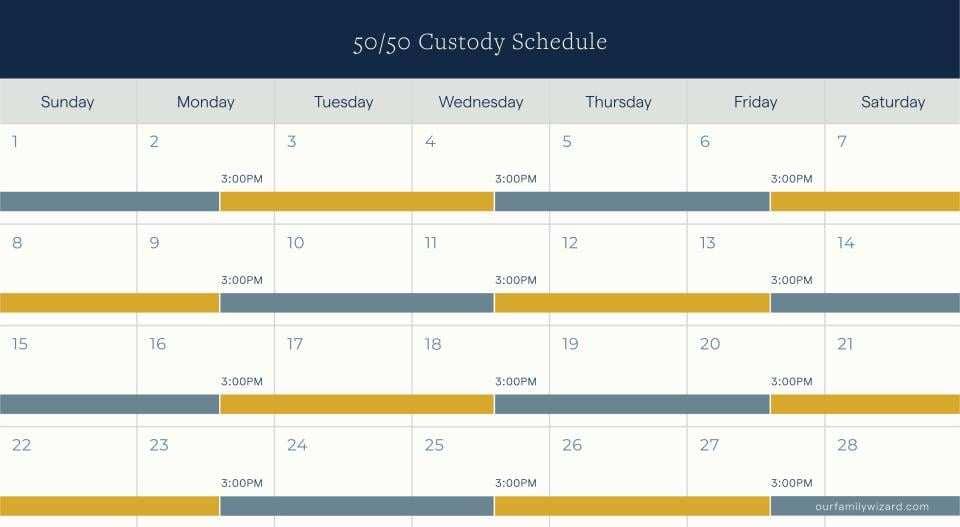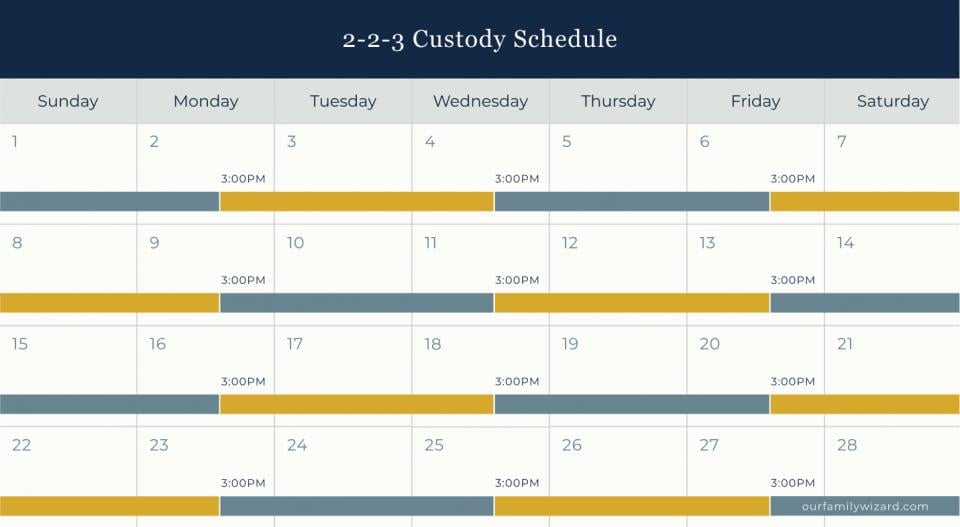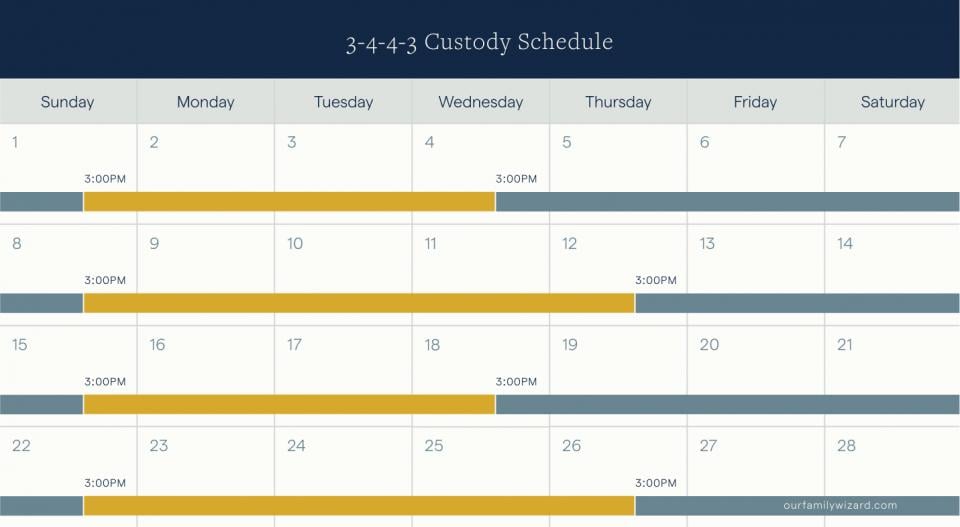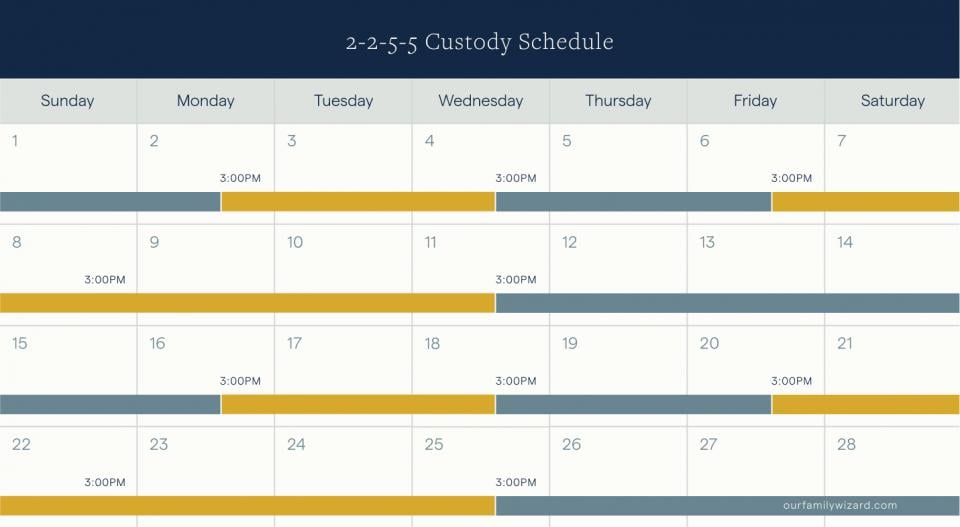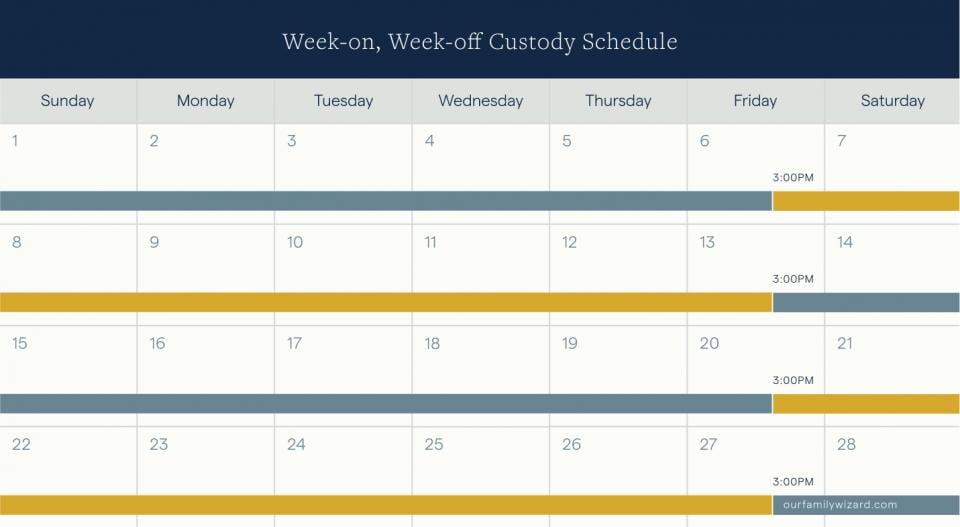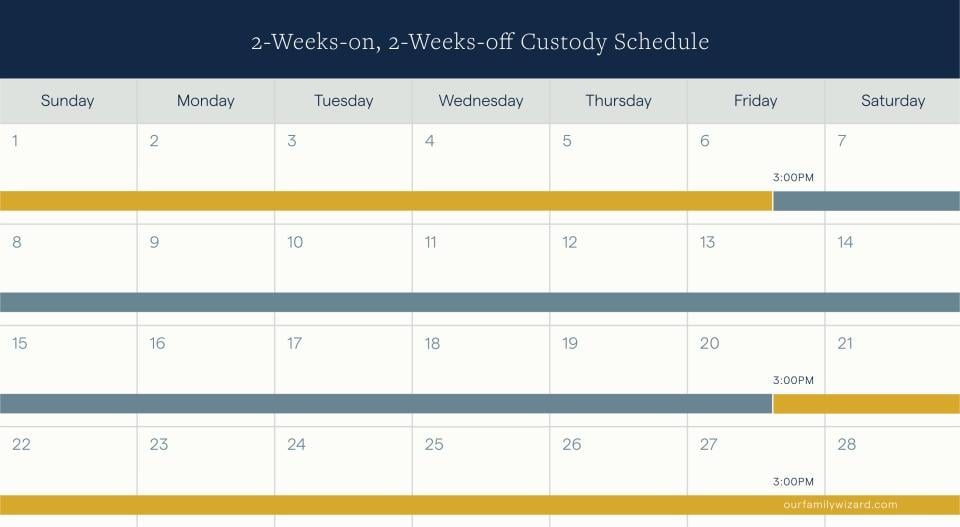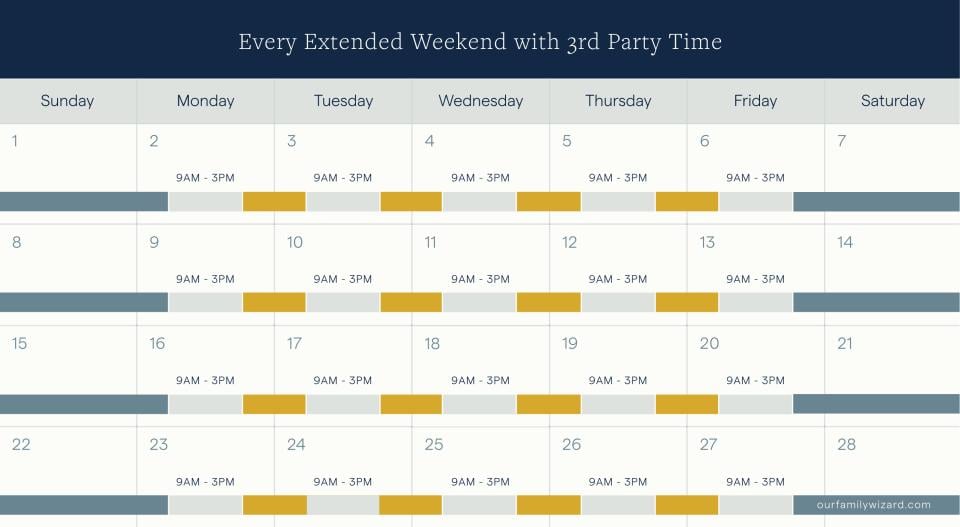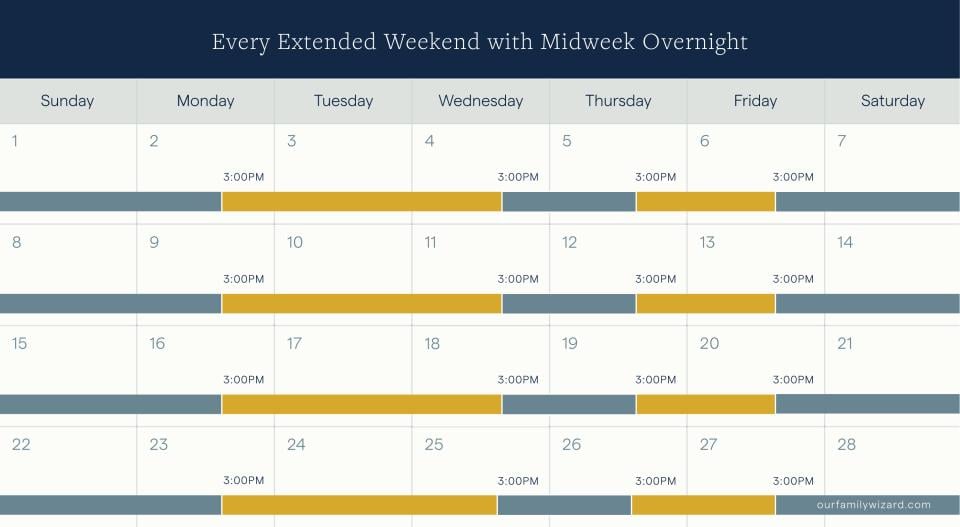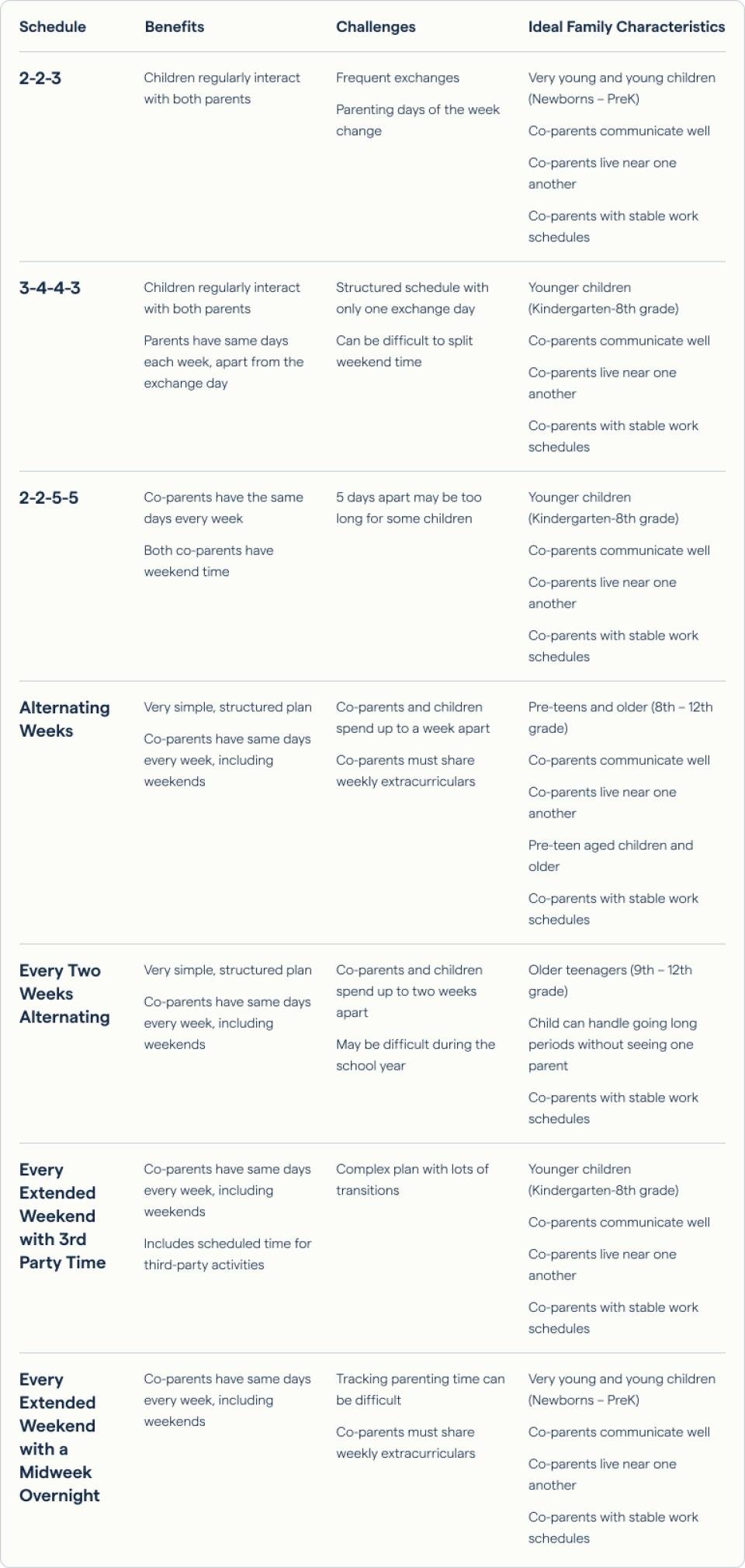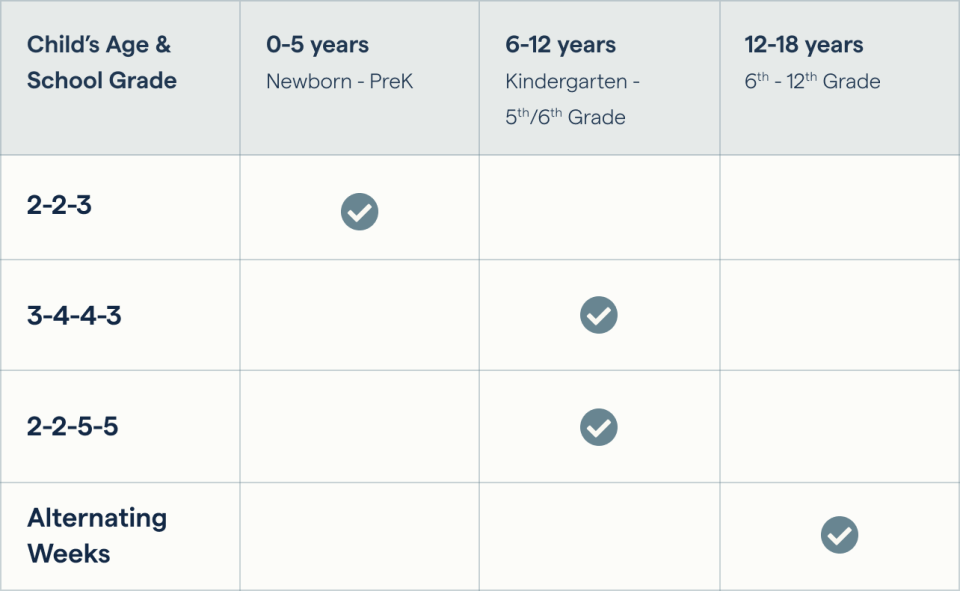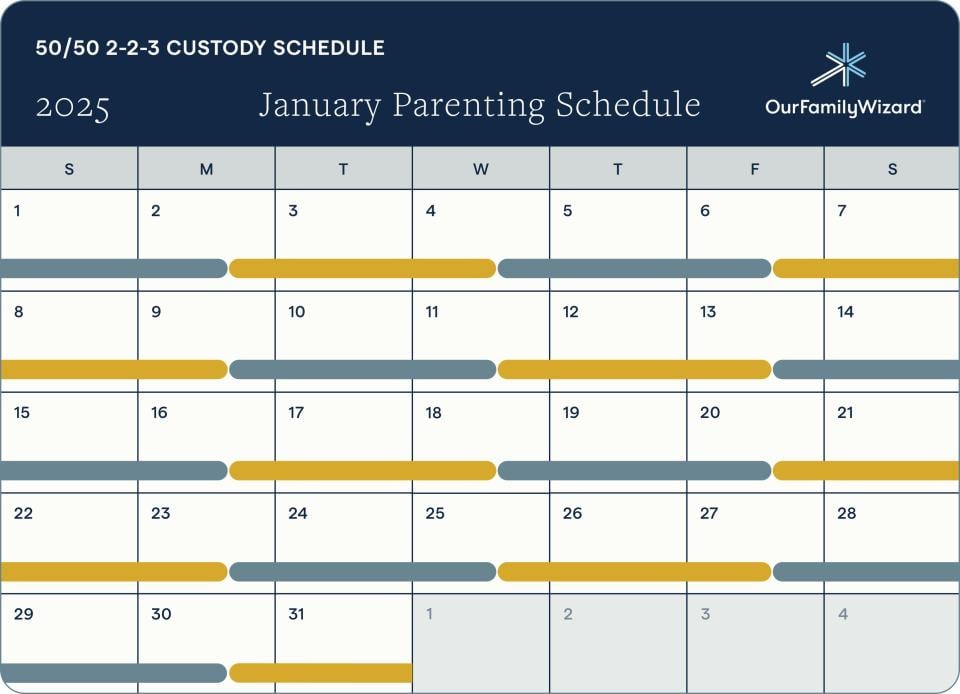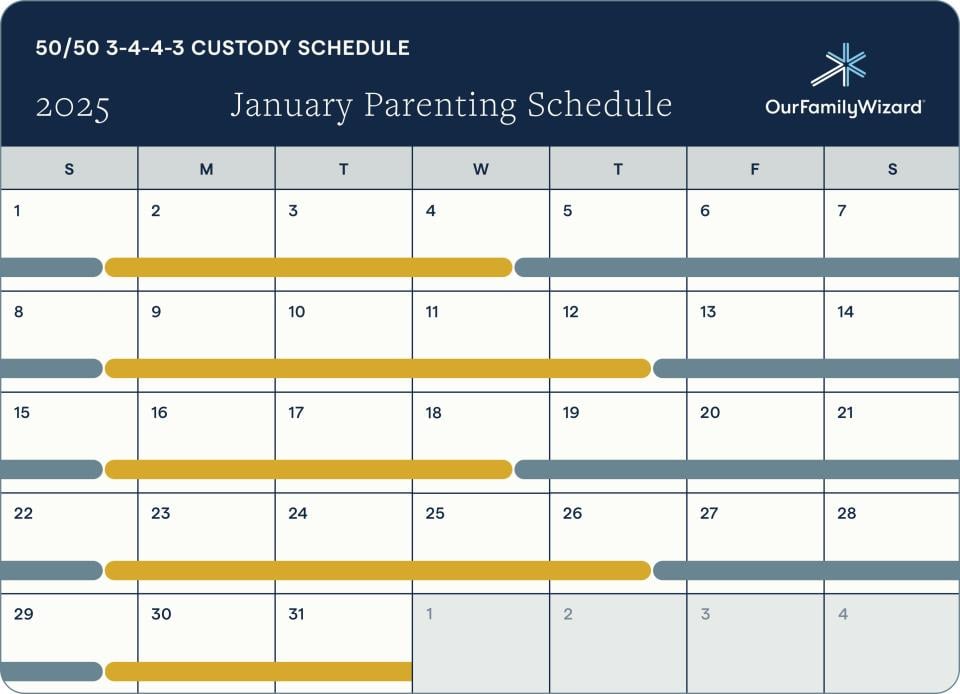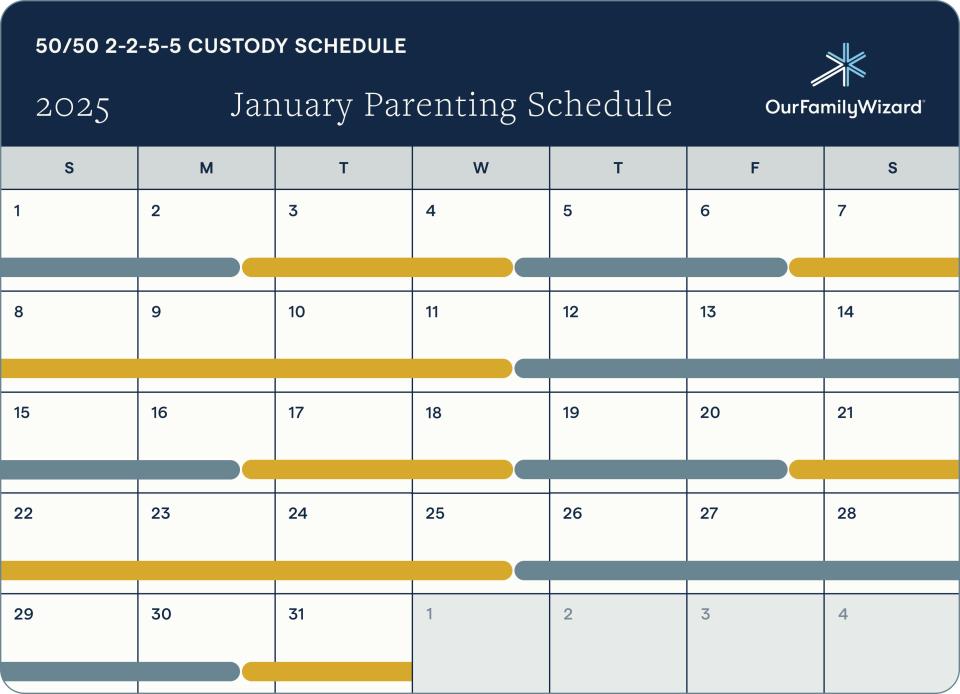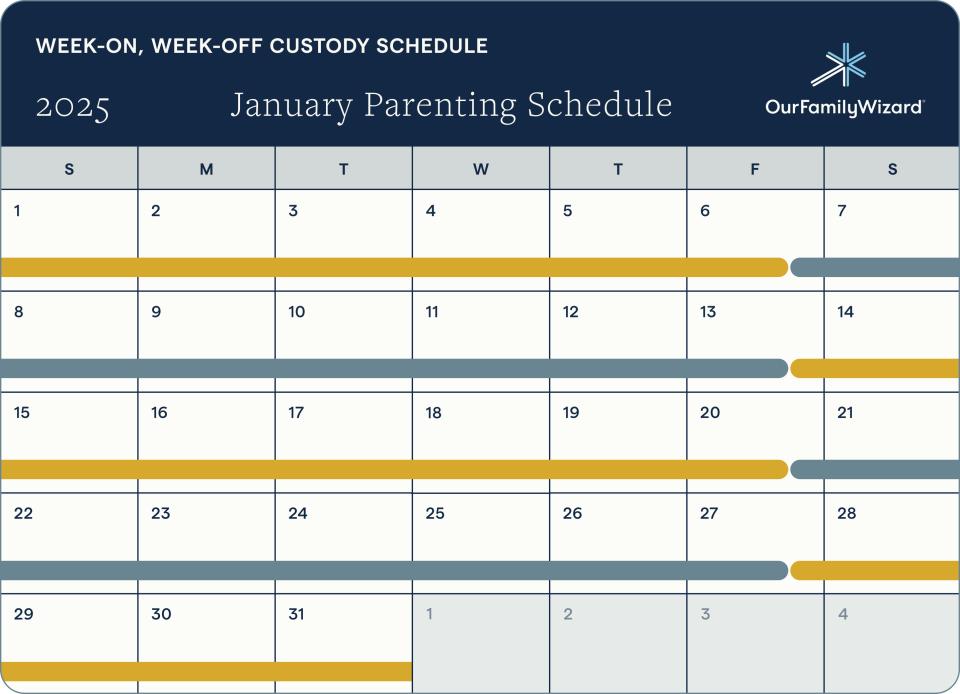50/50 Custody Schedules: Examples, Factors to Consider, Expert Tips and FAQs
During a divorce or separation, many co-parents decide to split parenting time equally with a 50/50 custody schedule. In this guide, experts compare 50/50 custody schedules to help you select the ideal schedule for your family.
Inside this article
- Comprehensive overview of different 50/50 parenting schedules
- Factors to consider when selecting a 50/50 parenting schedule
- How to pick the best 50/50 rotation for your family
- Experts suggest 50/50 custody schedules based on the child's age, needs, and mo…
- How to easily track 50/50 custody schedules
- Free 50/50 custody schedule templates
Listen to an educational podcast about 50/50 custody schedules*
What Is 50/50 Custody?
50/50 custody is a joint custody arrangement in which children spend time equally with each parent. This arrangement can benefit the children and co-parents. It can provide stability and deeper bonds with each parent. But the co-parents must coordinate well and live near each other.
50/50 custody, or 50/50 parenting time, has become a popular way to arrange child custody after divorce. As a result of the increased interest in 50/50 custody, researchers have turned their attention to understanding how 50/50 arrangements impact children. This body of work supports the idea that 50/50 schedules can benefit parents and children alike.
In the 2020 article "Children in dual-residence arrangements: a literature review," published in the Journal of Family Studies, Rakel Berman and Kristian Daneback analyze peer-reviewed research on how 50/50 schedules impact families and children. The article summarizes that "there is largely consensus among researchers that children in dual-residence arrangements are equally well, or often better off in several ways (health, risk, etc.) than children living with one parent only."
Shared custody has generally received a positive review across Western countries because it supports modern attachment theory. Attachment theory describes how a child's early relationships with their caregivers affect their emotional and social development. Research from the 1960's stressed that the child should have a home base, preferably with the mother. However, most experts find this idea outdated, and modern attachment theory supports the idea that the child may attach to multiple caregivers.
Attachment theory describes four styles of attachment bonds. Experts consider secure attachment to be the healthiest attachment. Children with secure attachments feel protected and comfortable around their caregivers. These children grow up with a sense of security and can feel confident in new environments and relationships.
Shared parenting schedules allow young children to form secure attachments with both parents. These interactions have long-lasting impacts on the children's psychological well-being, future relationships, and physical health. Supporting the development of secure attachment with a shared parenting plan can leave lasting imprints on your child's life.
But, as with all parenting schedules, the efficacy of shared custody depends on the characteristics of the family. In fact, in the aforementioned 2020 article, the authors describe that expert consensus on the benefits of 50/50 "is only valid when there is no ongoing conflict [and] if parents are able to cooperate." Also, experts stress that, with any parenting plan, children of appropriate age should have their preferences and opinions heard when deciding on a parenting plan.
 Michael Saini, Ph.D., M.S.W., R.S.W., Professor and Chair in Law and Social Work at the University of Toronto, echoes this sentiment: “The challenge for parents (and professionals who attempt to find the optimal parenting plan for the child) is to not assume a specific plan will always be the best fit. It is important to carve out a plan that could work best for their family circumstances, their child’s ages and stages of development, the relationship of the child with both parents, the practicalities and realities of each parent’s circumstances (e.g. distance between homes). Rather than presume that one plan will be the best plan for their child, they should consider an individualized assessment of the child’s best interest including the child’s views and preferences.”
Michael Saini, Ph.D., M.S.W., R.S.W., Professor and Chair in Law and Social Work at the University of Toronto, echoes this sentiment: “The challenge for parents (and professionals who attempt to find the optimal parenting plan for the child) is to not assume a specific plan will always be the best fit. It is important to carve out a plan that could work best for their family circumstances, their child’s ages and stages of development, the relationship of the child with both parents, the practicalities and realities of each parent’s circumstances (e.g. distance between homes). Rather than presume that one plan will be the best plan for their child, they should consider an individualized assessment of the child’s best interest including the child’s views and preferences.”
 Attorney Ron Lieberman, partner at family law firm Rigden Lieberman, LLC and chairperson of Family Law Section of the New Jersey State Bar Association, notes that the benefits from shared physical custody depend on the situation. "Equal shared physical custody can be worth the investment. Some benefits include more free time for the co-parents, a diverse upbringing, and equal parenting time for the child. But, if the parents live far from each other, travel can be lengthy and disruptive. Also, shared parenting might preclude a younger child from establishing structure with either parent."
Attorney Ron Lieberman, partner at family law firm Rigden Lieberman, LLC and chairperson of Family Law Section of the New Jersey State Bar Association, notes that the benefits from shared physical custody depend on the situation. "Equal shared physical custody can be worth the investment. Some benefits include more free time for the co-parents, a diverse upbringing, and equal parenting time for the child. But, if the parents live far from each other, travel can be lengthy and disruptive. Also, shared parenting might preclude a younger child from establishing structure with either parent."
Also, the specific emotional significance of splitting time down the middle should not supersede the goal of shared plans: to give children quality time with both parents. The efficacy of 50/50 can be very specific to the situation. Still, custody experts and experienced co-parents echo one common sentiment: 50/50 arrangements can benefit many families, so long as co-parents and anyone else involved firmly believe that the plan prioritizes the child's best interests.
Key Takeaways:
- Variety of 50/50 custody schedules: Common schedules cater to different family needs and logistics, ensuring flexibility and stability for children and parents.
- Child's needs as a priority: The best custody schedule depends on the child’s developmental stage, preferences, and the parents’ ability to minimize conflict and support a secure environment.
- Proximity and cooperation matter: 50/50 schedules work best when parents live close to one another, communicate effectively, and minimize conflict.
- Attachment and age considerations: Younger children benefit from frequent exchanges to build secure attachments, while older children and teenagers can adapt to longer intervals.
- Effective tools for co-parenting: Apps like OurFamilyWizard help parents track custody schedules, manage communication, and adjust plans flexibly, reducing logistical stress and focusing on the children’s wellbeing.
Simplify your 50/50 custody schedule
Keep your co-parenting organized with OurFamilyWizard.
Examples of Different 50/50 Custody Schedules
Families can select from the different 50/50 schedules based on the needs of their children and their work schedules. For example, families with older teenagers may enjoy the alternating weeks schedule. On the other hand, families who want frequent exchanges may thrive under 2-2-3.
Here's a list of the most popular 50/50 custody schedules. It includes their benefits, challenges, and a quick overview of the type of family who will thrive under each plan. Of course, a schedule that suits one family perfectly may prove challenging for another.
We've organized the schedules by frequency of child exchanges, starting with the most frequent and ending with the least.
2-2-3 Custody Schedule
Month view of a 2-2-3 parenting schedule
- 2-2-3 custody schedules
Summary, benefits, and challenges
In the 2-2-3 schedule, the first co-parent spends two days with the children, and then the children go to the other parent for the next two days. Then, the children spend the last three days of the week with the first co-parent. Next week, the parents will swap their days, so each co-parent spends every other weekend with the children. The major benefit of this schedule is that co-parents and kids don't spend more than three days apart. The major challenge is handling frequent transitions.
Who 2-2-3 works best for
This schedule involves frequent exchanges and transitions, so experts recommend that co-parents live close to one another to adopt this schedule. Co-parents must regularly interact, so they should have a relatively tension-free relationship. Experts recommend this schedule for younger children, who need time with both parents to form healthy relationships.
3-4-4-3 Custody Schedule
Month view of the 3-4-4-3 parenting plan
- 3-4-4-3 custody schedule
Summary, benefits, and challenges
The 3-4-4-3 rotation breaks the week up into three- and four-day periods. With the 3-4-4-3 plan, the kids spend three days with one co-parent and then four days with another. Then, co-parents reverse the order: The children go with the first co-parent for four days and the second for three. Don't confuse this schedule with the 4-3 schedule, which is a 60/40 split.
3-4-4-3 doesn't keep kids apart from either co-parent for too long. The structured plan requires only a single exchange day a week, which helps co-parents structure their free time and creates a schedule that kids can easily remember. In some cases, 3-4-4-3 gives only one parent weekend time, which can be stressful. Also, children may not enjoy swapping homes every week.
Who 3-4-4-3 works best for
Co-parents with structured schedules who live near one another will likely enjoy 3-4-4-3. The schedule works best for younger children who need to see both parents regularly.
2-2-5-5 Custody Schedule
Month view of the 2-2-5-5 parenting plan
- 2-2-5-5 custody schedule
Summary, benefits, and challenges
Under 2-2-5-5, co-parents split two-week intervals into two- and five-day periods. The child spends two days with one co-parent and then two days with another. Then, they spend five days with the first co-parent and five days with the other. Many co-parents enjoy this schedule because it allows for a 50/50 split that minimizes time apart and enables co-parents to keep a consistent schedule. Notably, co-parents keep the same days every week. However, the schedule can be challenging for children who don't enjoy frequently switching homes. It also demands that co-parents communicate effectively.
Who 2-2-5-5 works best for
2-2-5-5 suits co-parents and kids that have schedules amenable to frequent exchanges. This plan can be a good fit for younger children who have formed attachment styles but still want regular contact with both parents.
Alternating Weeks Custody Schedule
Month view of the alternating weeks parenting plan
- Alternating weeks custody schedule
Summary, benefits, and challenges
The alternating weeks parenting plan splits up parenting time in one-week intervals. Here, the children spend one week with one co-parent and then one week with another. This classic schedule offers a simple, easy-to-manage schedule. Also, the week-long stays give parents and children ample time with one another. However, the plan presents challenges for co-parents with very young children, who may struggle with a week apart from either co-parent.
Who alternating weeks works best for
This parenting plan will be a great fit for pre-teens and teenagers who already have relationships with both co-parents and have an active life outside of family time. In general, most co-parents enjoy less frequent changeovers and extended time together.
Uncommon 50/50 Parenting Schedules
Atypical 50/50 parenting schedules can work for some families. For example, some families may choose to alternate custody every two weeks. Also, some co-parents add a midweek overnight to a 4-3 schedule.
The most common co-parenting 50/50 plans include 2-2-3, 3-4-4-3, 2-2-5-5, and alternating weeks. However, some more uncommon arrangements also exist, like alternating custody every two weeks. Most experts don’t recommend these uncommon arrangements because they either introduce complicated logistics or keep children away from a co-parent for too long.
Here's a summary of three uncommon 50/50 rotations.
Every Two-Weeks Alternating Custody Schedule
Month view of the two-week alternating schedule
- Alternating every two weeks
In this schedule, co-parents alternate custody on a 2-week basis. This schedule is extremely rare because two weeks away from a parent will even stress a teenager. This schedule would be particularly challenging during the school year.
Every Extended Weekend with 3rd Party Time Custody Schedule
Month view of an every extended weekend schedule with 3rd party time
- Every extended weekend with 3rd party time
The every extended weekend schedule is a version of the 4-3 custody schedule that starts on Monday. Here, one co-parent has the child for four overnights (Monday—Thursday), and the other co-parent has the children for a long weekend (Friday—Sunday).
Some families find that when they consider third-party time, such as when the child is at daycare or school, the schedule evens out to a 50/50 split. Whether or not this will work for you depends on your work schedules, and your children’s school and extracurricular schedules. This split is uncommon but can work for families that agree to 4-3. However, it will only work if co-parents can track quality time very accurately.
Every Extended Weekend with a Midweek Overnight Custody Schedule
Month view of an every extended weekend schedule with a midweek overnight
- Every extended weekend with a midweek overnight
In the every extended weekend schedule, one co-parent that usually takes the children on the weekends can add in a midweek overnight every other week to approximate a 50/50 split.
This schedule is also rare and demands that co-parents track quality time together very accurately.
Factors to Consider When Choosing a 50/50 Custody Schedule
All 50/50 parenting schedules require that co-parents communicate well, minimize conflict, and live near one another. Other factors, like your children's age and your work schedules, will help narrow the options.
50/50 custody schedules come in all types of shapes and sizes. Each plan caters to specific types of families with certain needs.
According to Dr. Saini, “Research does not point to the ideal type of family or child that benefits most from a 50/50 schedule. Instead, it’s best to look at the individual factors that should be considered in each case. A parenting plan arrangement, regardless of the time the child spends with both parents, should foster a decreased level of conflict, provide sufficient structure so that both parents are clear about the routines and expectations in each home, and assist the child to adjust to the plan by being clear about the schedule and avoiding miscommunications and misunderstandings about the child’s overall schedule.”
New York family law attorney Lisa Zeiderman suggests that co-parents discuss the following questions when weighing the different scheduling options:
- Is a 50/50 schedule best for your child?
- Would your child benefit from the stability of being in one household as a home base?
- Does your child have special needs or challenges that one parent is better equipped to handle?
- Does each parent's work schedule lend itself to a 50/50 plan, or is one parent better able to accommodate the child's needs?
- Can both co-parents get on the same page for the rules of the road—i.e., similar rules about homework, bedtime, curfews, and mealtime? Or are the households so different that the child may feel disjointed?
- Is there a greater bond for the child with one parent versus the other?
Along with Zeiderman's points, co-parents should consider the following factors:
- Geographic distance
For a 50/50 schedule to work well, co-parents must live near one another to avoid complicated and stressful logistics. - Conflict and communication between co-parents
Conflict between co-parents may hinder the success of 50/50 custody. If co-parents have difficulty cooperating, they should consider schedules that minimize tense interactions, especially in front of the children.
In their 2020 review of shared parenting research, Berman and Daneback cite multiple peer-reviewed studies that show that "children and adolescents are likely to feel caught between their parents if there is a severe conflict." The researchers continue: "Living within and between ongoing disputes, persistent conflicts and emotional preoccupation may make dual residence a bad solution for some."
However, some research suggests that maintaining a relationship with both parents can outweigh the negatives of the child seeing their parents in conflict.
For example, Nicole E. Mahrer and co-authors found that the negative effect of inter-parental conflict depends on whether conflict is persistent over time. They review 11 studies in their article, "Does Shared Parenting Help or Hurt Children in High-Conflict Divorced Families?" published in 2018 in the Journal of Divorce & Remarriage. The researchers found that children become more well-adjusted when they form high-quality relationships with both parents, even in high-conflict families.
In high-conflict situations that don't necessarily preclude a 50/50 schedule, co-parents may consider parallel parenting. Parallel parenting limits communication between the co-parents to avoid conflict. - Work schedules
Your professional commitments factor into whether you can handle the 50/50 schedule. For example, traditional 9-5 jobs may be easier to fit around a 50/50 schedule than jobs with irregular schedules. A shared calendar will help you visualize how your different work commitments will affect the plan's logistics. - Activity and school schedules
Of course, you're not the only one with a schedule to consider. Map your child's current and planned activities and school schedules to ensure each co-parent can be available and involved as needed.
What Is the Best 50/50 Custody Schedule?
The best 50/50 custody schedule is the one that helps the children the most and causes the least stress for the co-parents. No single schedule will work for every family. Each family should look at their situation and choose a schedule that best meets their children's needs.
No expert can prescribe a single parenting plan without understanding the family's circumstances. Many experts suggest that families seek guidance on different arrangements. Of course, if your children are old enough to form an articulate opinion, you should prioritize their needs and values above all else.
How to Pick the Best 50/50 Rotation for Your Family
Co-parents should prioritize the rotation that best fits their child's needs. Experts advise considering the specific needs of your child's age group when selecting a rotation. Then, consider whether both co-parents can logistically support a given schedule.
Here's an overview of the most common 50/50 schedule options to help you compare and choose:
Suggested 50/50 Custody Schedules by Age
Young children do best with frequent exchanges, while teenagers can handle longer times apart. Therefore, many experts recommend families with young children start with 2-2-3 and work up to alternating weeks as the children age.
Attorney Zeiderman shares her recommendations for the best custody schedules per age group:
- Newborns and toddlers (pre-K)
"For very young children, we often start with a 2-2-3 schedule," says Zeiderman.
Her recommendation stems from the idea that young children and babies need a consistent routine. They also should interact with both parents meaningfully to form secure, healthy attachments.
Co-parents should consider the needs of breastfeeding newborns and allow the mother extra time with the child. - Kindergarten-6th grade (ages 5-12)
"Between kindergarten and 2nd or 3rd grade, we recommend the 5-2-2-5," says Zeiderman.
The 5-2-2-5 provides easier logistics than the 2-2-3 but still gives children meaningful time with both parents without too much time apart. But the 2-2-3 may also still work, particularly for younger children in this group.
"If elementary and middle-school children want less transitioning, we move to the alternating weeks schedule," Zeiderman says. However, co-parents usually keep their kids on a 5-2-2-5, or 3-4-4-3, until they're around 11 or 12 and can articulate well-formed opinions. - 6th grade through high school (tweens and teens)
Around 11 or 12, your child can articulate themselves and form preferences. You can take their input to heart and ask them why they prefer a particular rotation.
"For teens, the alternating weeks schedule works well, so long as the parents are true joint custodians and can accommodate this schedule," Zeiderman says.
Many teenagers prefer the alternating weeks schedule because it minimizes how much time they spend moving from home to home. Around this time, your children will begin to prioritize their own social circles and extracurricular activities. Plus, teenagers will already have formed relationships with both co-parents and can probably handle longer times apart from each co-parent. At this stage, your teenagers will want to feel fully in control of their schedule and may resent any rotation that doesn't provide them with ample flexibility and independence.
Use these recommendations as a starting point. The guidelines should never outweigh the specific needs of your child. Also, make sure that the rotation is realistic. There's no use in selecting the perfect rotation for the child if one or both co-parents cannot keep up with its demands.
Personalize your 50/50 custody schedule to serve your family’s situation best. Use our 50/50 custody schedule templates to visualize how a schedule will work for your family.
50/50 Custody Schedule Ideas
A 50/50 custody schedule can take different forms, such as alternating weeks, 2-2-3 or 2-3-2. Another option is a week-on/week-off schedule with a midweek overnight visit. Consider the child's age and schedule, proximity of the homes, and work schedules.
Download our cheat sheet on all possible 50/50 custody schedule rotations
Easiest Way to Track 50/50 Custody Schedules
Many co-parents want to share family time but have difficulty organizing their schedules together. Lean on OurFamilyWizard scheduling app for help. OurFamilyWizard keeps communication lines open and clear, ensuring nothing gets lost in translation.
The shared co-parenting calendar from OurFamilyWizard syncs co-parents' schedules into a single, shared calendar. More than just a calendar, OurFamilyWizard has additional features that help you co-parent together. For example, you can use the app to send your co-parent secure messages, track expenses and reimbursements, share photos and files, and much more.
OurFamilyWizard knows that any good parenting plan should have room for flexibility. OurFamilyWizard's schedule change request tool provides a simple, straightforward way to request changes to the schedule, whether you want an extra dinner with your children or need to accommodate a sudden shift in your work schedule. OurFamilyWizard has you covered for schedule changes, holiday plans, and more.
Co-parenting should be about parenting together, not about schedule management. OurFamilyWizard keeps co-parents in sync to work together on what matters most: raising healthy, happy children.
50/50 Co-parenting Schedule FAQs
People often have questions about 50/50 schedules. For example, you may wonder which schedule is most popular or works for younger children. Also, some co-parents who live far from one another wonder if they can make the 50/50 rotation work.
What Is the Most Popular 50/50 Schedule?
Among 50/50 schedules, the 5-2-2-5 and alternating weeks schedules are the most popular. These schedules have longer periods apart than 2-2-3 but don't require as much upfront planning or communication.
Attorney Zeiderman lists 5-2-2-5 and alternating weeks as the two most popular schedules.
"I would say that there are two plans that work," says Zeiderman. "5-2-2-5 is extremely popular, but it means lots of transitions for the child. Some children do very well with this plan, but other children dislike the transition. Children may get frustrated when they have to make sure they don't forget their schoolwork, sports equipment, musical instruments, etc. For some children, this schedule can feel too overwhelming. Also, some children miss the other parent during the longer stretch of time."
Zeiderman continues: "Another popular 50/50 plan is alternating weeks, starting on Friday after school so that the child has the weekend to adjust to the transition. Usually, we also have a mid-week dinner for the parent who does not have the week so that the child is not going so long without seeing a parent."
Which 50/50 Custody Schedule Is Best for Toddlers?
Most experts recommend that co-parents with toddlers use the 2-2-3 schedule. This schedule minimizes the time a toddler spends apart from either co-parent. In addition, this consistency provides the stability young children need and allows them to form meaningful relationships with both parents.
Which 50/50 Custody Schedule Is Best When There Is a Long Distance Between Co-parents' Houses?
50/50 schedules don't work well when co-parents live far from one another. In this situation, the alternating weeks schedule can work because it requires only one day of commuting per week. If this schedule doesn't fit the child's needs, consider a 60/40 or a 70/30 split.
Which 50/50 Custody Schedule Is Best for Summer?
The best 50/50 custody schedule for summer depends on your family's schedule and your child's age. Over the summer, you should switch to a 50/50 schedule that considers summer activities but still provides quality time with both parents.
What Age Is Best for Week on Week of Custody?
Week-on/week-off custody works best for tweens and teenagers. At this age, your children do fine with longer time apart from each parent. Also, teenagers enjoy more independence and flexibility and won't want to spend much time transitioning between homes.
Who Is Responsible for the 50/50 Custody Schedule?
The responsibility for creating and following the 50/50 custody schedule falls on both co-parents. Co-parents must cooperate to decide which schedule will work well for their family and children. Also, they'll need to communicate well to make any adjustments.
A Note on Terminology
In general, the term “physical custody” refers to which parent a child lives with. Today, many experts use other terms to describe this arrangement, like “parenting schedule” or “parenting time arrangement.” These new terms better represent a relationship and the parent’s responsibilities for their children. But just a heads up: this article uses these older and newer terms interchangeably.
*Educational podcast generated by Google NotebookLM

